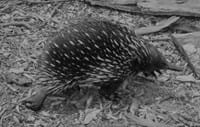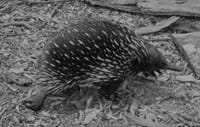THE DESIGN PROCESS

How and Why?
My aim is to make a piece of jewellery that reflects the animal’s footprint and is sympathetic in shape and design to the animal track. I want to provide tourists, travellers and animal lovers with a permanent memento of a unique experience; such as coming across an animal in the bush, watching it eat, rest, snort, or scuffle.
Every time I design a piece it becomes an adventure. The research often reveals unusual facts and fond memories of each animal.
Researching the echidna taught me that originally, museums in Europe mistakenly displayed the hind foot back-to-front. You can see why in the opposite photo - the toes face backwards. I also loved finding out that echidnas are loners, roamers and escape artists who can dig through concrete and even clamber up inside drainpipes to go wandering!
The Footprint
The next part of the process is to identify an iconic footprint of the animal I’m researching. Then I have to draw it as a silhouette that is easily recognizable yet simple enough to be cut out of a small piece of precious metal without losing its substance or form. Once I have the design of the footprint, I photocopy it many times and draw frames around the footprint until I find one which feels most sympathetic to the footprint.
While designing the snow leopard pieces, I learnt that their large paws resemble old -fashioned snow shoes, which facilitate walking in soft snow. So I tried to incorporate the shape of a snow shoe in the shape of the piece.
Then I make the piece in silver, refining the design until I am satisfied. The actual piece always has a slightly different appearance to a flat drawing. I also have to think about things like weight, not only because of the use of precious metal but also the pull on one’s earlobes!
The final design stage is to draw a picture of the animal and cull all the facts I’ve learnt about it to a few short observations to go on the sleeve of the box. The hardest part is deciding what to leave in and what to leave out.
Challenging Bits
Two of the most challenging designs I’ve done to date are the Wedge-tail Eagle and the Saltwater Crocodile or ‘saltie’. I’ve been given very generous and enthusiastic support from wildlife conservationists, researchers and enthusiasts with both these and other animals.
The Wedge-Tail Eagle Prints
The wedge-tail eagle flies, so its not easy to find footprints.
A resourceful man of science by the name of Dr Walter Boles (from the Australian Museum) helped me with the eagle. He used eagle feet they had preserved at the museum for educational activities. These had been prepared in a standing posture with the toes spread, so were perfect footprints, if not recognisable tracks.
Walter pressed these feet into a soft substrate (if I recall correctly it was pink Play Doh), and sent me photographs of the results, along with a lot of interesting facts about the Wedge-tail Eagle.
The Saltwater Crocodile Print
The search for a crocodile track also provided some wonderful experiences.
The crocodile does walk on sand and mud, but the tail dragging behind the feet make it a messy, rather indistinctive track. These aspects are not conducive to obviously recognisable footprints, but the animals are so iconic to Australia that I had to included them the range.
I first met Chris Parker, who was working at Ballarat Wildlife Park at the time. His enthusiasm and interaction with wildlife was a wonderful thing to experience. Chris not only lifted his shirt to show me Wedgetail Eagle claw scars on his chest, he also happily held a thrashing young crocodile named Eric in his hands so I could photograph its feet. Sadly the photographs were not usable. Eric, despite being half my size, scared me witless with his vigorous thrashing; my frantic backpedalling combined with his wild movements made for very out-of-focus pictures. Luckily I obtained some other prints from various zoos and conservation outlets.

Thank You
Perhaps this is the best part of what I do; the support and knowledge sharing I have experienced freely from so many wildlife enthusiasts, sanctuaries and stockists. There are so many, far more than I can give credit to. Because of their conservation efforts, the animals I love continue to exist, and I am able to continue to do what I love.















